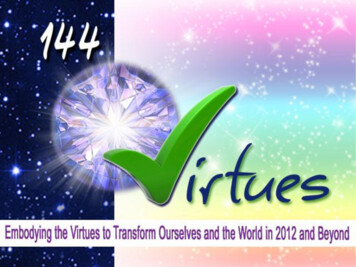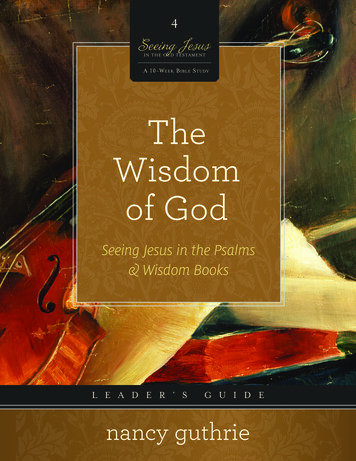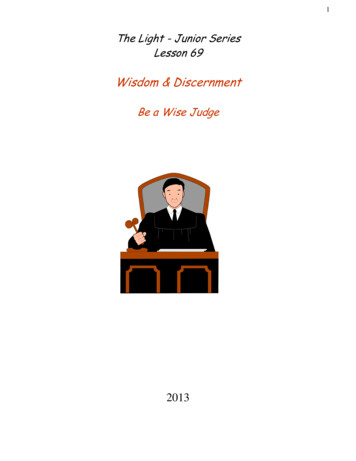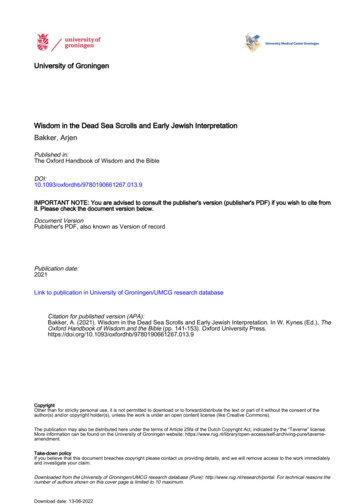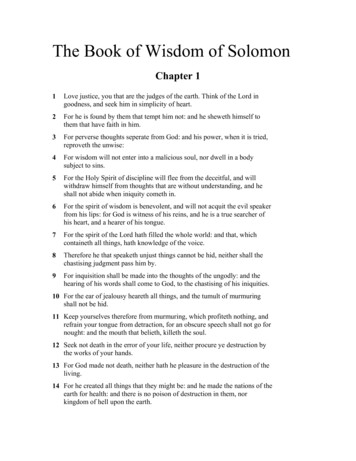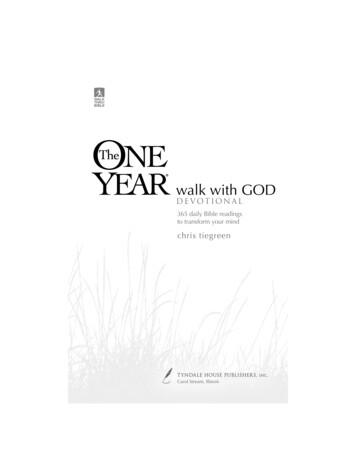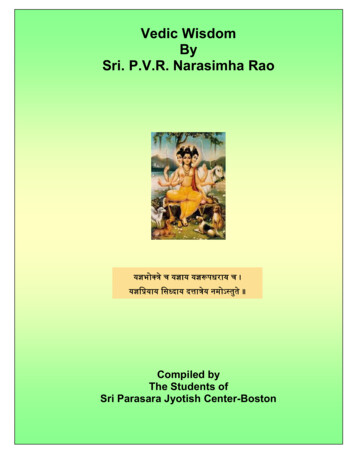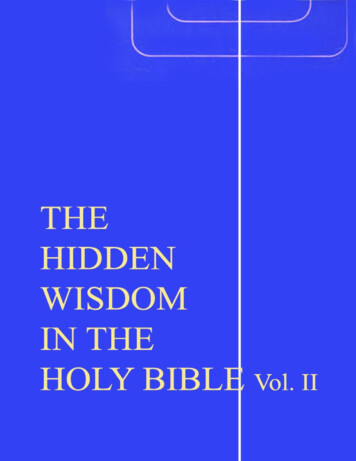
Transcription
BY THE SAME AUTHORTHE ANGELIC HIERARCHYFairies at Work and at Play. English and French Editions.The Kingdom of Faerie.The Brotherhood of Angels and of Men.Be Ye Perfect.The Angelic. Hosts.Man, The Triune God.The Supreme Splendour.The Coming of the Angels.The Kingdom of the Gods. Illustrated.THE SPIRITUAL LIFEFirst Steps on the Path.Thus Have I Heard.Meditations on the Occult Life. English and German Editions.The Pathway to Perfection.Destiny.The Inner Side of Chur ch Worship.THE POWERS LATENT IN MANThe Science of Seership. English and French Editions.Clairvoyance and the Serpent Fire.Occult Powers in Nature and in Man.Man’s Supersensory and Spiritual Powers.The Soul’s Awakening. American Edition.A Yoga of Light. English, Danish and Spanish Editions.Some Experiments in Four-Dimensional Vision.
The Psychedelic and the Yogic Pathways to Reality.THE THEOSOPHICAL PHILOSOPHY OF LIFETheosophy Answers Some Problems of Life.Vital Questions Answered.Reincarnation, Fact or Fallacy? Indian, American and Arabic Editions.The Miracle of Birth.The Spiritual Significance of Motherhood. English and Spanish Editions.Through the Gateway of Death.The Seven Human Temperaments.The School of the Wisdom Lecture Notes, Vol. I (Revised Edition).INTERPRETATIONS OF SCRIPTURES AND MYTHSThe Hidden Wisdom in the Holy Bible, Vols. I. II and III, Indian andAmerican Editions.The Hidden Wisdom in the Christian Scriptures. American Edition.The Divine Wisdom in the Christian Scriptures. New Zealand Edition.HEALTHHealth and the Spiritual Life.New Light on the Problem of Disease.An Occult View of Health and Disease.The Way to Perfect Health, Spiritual, Mental and Physical.Radiant Health From a Meat-free Dietary.Plant Foods, Their Nutrient Properties.The Case for Vegetarianism.ANIMAL WELFAREAn Animal’s Bill of Rights.The Humanitarian Cause, Its Extreme Urgency.Animals and Men. The Ideal Relationship.Authentic Stories of Intelligence in Animals.
Our Friends the Animals.
THE HIDDEN WISDOMIN THE HOLY BIBLEBYGEOFFREY HODSONVOLUME II
THE GOLDEN GRAIN OF WISDOM IN THE BOOK OF GENESIS(Genesis—Chapters One to Twenty-five)THE THEOSOPHICAL PUBLISHING HOUSEAdyar, Madras 600 020, IndiaWheaton, III., U.S.A. London, England The TheosophicalPublishing House, 1967First Edition 1967Second and Revised Edition 1972Reprinted 1986SBN 0-7229-7057-9ISBN 0-8356-7057-0Printed at the Vasanta PressThe Theosophical Society,Adyar, Madras 600 020, India.
DEDICATIONThis work is dedicated to Philo Judaeus, the great Alexandrian Sage.
ACKNOWLEDGEMENTSI acknowledge with gratitude the help in the production of this work receivedfrom my wife, Sandra, who at dictation wrote out all the original interpretationsof Biblical passages, and is continuing to do so; my valued literary assistant,Myra G. Fraser; and my friend Nell K. Griffith, who for many years cared formy domestic needs and assisted in typing from the first draft of the manuscript. Ialso wish to express my heartfelt thanks to my valued friends, Roma and BrianDunningham, for their unfailing support, their provision of stenographers, andtheir generous help throughout many years of collaboration.All quotations and references in this work are taken from the King JamesVersion of the Holy Bible.THE HIDDEN WISDOM AND WHY IT IS CONCEALEDTHE greatest degree of power which occult science can bestow is to bederived from knowledge of the unity and interaction between the Macrocosmand the microcosm, the Universe and man. “The mystery of the earthly andmortal man is after the mystery of the supernal and immortal One”, wroteEliphas Levi. Lao Tzu also expresses this truth in his words: “The Universe is aman on a large scale.”The whole Universe with all its parts, from the highest plane down tophysical Nature, is regarded as being interlocked, interwoven to make a singlewhole—one body, one organism, one power, one life, one consciousness, allcyclically evolving under one law. The “organs” or parts of the Macrocosm,though apparently separated in space and plane of manifestation, are in factharmoniously interrelated, intercommunicative and continually interactive.According to this revelation of occult philosophy the Zodiac, the Galaxiesand their component Systems, and the planets with their kingdoms and planes ofNature, elements, Orders of Beings, radiating forces, colours and notes, are notonly parts of a co-ordinated whole and in “correspondence”or mutual resonancewith each other, but also—which is of profound significance—have theirrepresentations within man himself. This system of correspondences is inoperation throughout the whole of the microcosm, from the Monad to the mortalflesh, including the parts of the mechanism of consciousness, or vehicles and
their chakras,1 by means of which the Spirit of man is manifested throughout hiswhole nature, varying in degree according to the stage of evolutionarydevelopment. The human being who discovers this truth could enter the poweraspect of the Universe and tap any one of these forces. He would then becomeendowed with almost irresistible influence over both Nature and his fellow men.H.P. Blavatsky writes:2“The danger was that such doctrines as the Planetary Chain, or the sevenRaces, at once give a clue to the seven-fold nature of man, for each principle iscorrelated to a plane, a planet, and a race, and the human principles are, on everyplane, correlated to seven-fold occult forces, those of the higher planes being oftremendous power. So that any septenary division at once fives a clue totremendous occult powers, the abuse of which would cause incalculable evil tohumanity; a clue which is, perhaps, no clue to the present generation—especiallyto Westerns, protected as they are by their very blindness and ignorantmaterialistic disbelief in the occult—but a clue which would, nevertheless, havebeen very real in the early centuries of the Chr istian era to people fullyconvinced of the reality of Occultism, and entering a cycle of degradation whichmade them rife for abuse of occult powers and sorcery of the worst description.“The documents were concealed, it is true, but the knowledge itself and itsactual existence was never made a secret of by the Hierophants of the Temples,wherein the MYSTERIES have ever been made a discipline and stimulus tovirtue. This is very old news, and was repeatedly made known by the greatAdepts, from Pythagoras and Plato down to the Neo- Platonists. It was the newreligion of the Nazarenes that wrought a change—for the worse—in the policyof centuries.”In his Toga Aphorisms, Patanjali writes:3“The (successful) ascetic acquires complete control over the elements byconcentrating his mind upon the five classes of properties in the manifesteduniverse; as, first, those of gross or phenomenal character; second, those ofform; third, those of subtle quality; fourth, those susceptible of distinction as tolight, action, and inertia; fifth, those having influence in their various degrees forthe production of fruits through their effects upon the mind.“From the acquirement of such power over the elements there results to theascetic various perfections, to wit, the power to project his inner-self into thesmallest atom, to expand his inner-self to the size of the largest body, to render
his material body light or heavy at will, to give indefinite extension to his astralbody or its separate members, to exercise an irresistible will upon the minds ofothers, to obtain the highest excellence of the material body, and the ability topreserve such excellence when obtained.“Excellence of the material body consists in colour, loveliness of form,strength, and density.”This knowledge of the relationship between Universe and man is also part ofthe secret wisdom of Kabbalism, which teaches that in the chain of beingeverything is magically contained within everything else. Where one stands,there stand all the worlds; what is below is above, what is inside is outside and,in addition, ceaselessly acts upon all that exists. Kabbalism thus stresses theinter-relationship of all worlds and levels of being according to exact, thoughunfathomable, laws. All things, moreover, possess their infinite depths whichfrom every point may be contemplated.Such is a portion of the wisdom which is said to be implicit—and, indeed,revealed under the veil of allegory—in the Torah4 This sacred book is forKabbalists a revelation of the laws of the Cosmos and the intimate and activerelationship between the parts of the Cosmos, the Spirit of man, and the vehiclesin which that Spirit is incarnate. The historv of the Jews forms a foundation uponwhich the edifice of this secret knowledge is erected. Modern Christian theologywould seem to have fallen into the grievous error of regarding the sub-structureof meta- phoricised history as a total and divinely inspired revelation of God’sguidance to mankind.The mission of the Jews and the purpose of the erudite and Initiated authorsof the Bible was, I submit, to preserve, to enunciate and to deliver to humanitythis wisdom of the Chaldeo-Hebrew Sanctuaries. It is for this and not forlordship over the Earth, I suggest, that the Jews were a chosen people, a nationor “kingdom of priests”5 in very truth. May not their tribulations have partlyarisen from their neglect of this mission, and may not their earthly wanderingsand centuries of physical homelessness have followed upon.and resulted fromtheir departure from their true Sanctuary and the real purpose for which theywere “chosen”? Happily the light still shines, however deeply veiled, in andthrough this marvellous record of the Scriptures of the Hebrew Race.The task of unveiling the hidden truth demands some knowledge ofCosmogenesis, of the emanation of the Universe from the Absolute, the finite
from the Infinite, and of the successive cycles, major and minor, of involutionand evolution. In addition, both knowledge of the Symbolical Language, itspurposes, methods and classical symbols, and the faculty of analysing andinterpreting historical metaphors, are necessary to open the casket containing thetreasures of concealed wisdom—the Holy Bible itself.“Where the Word found that things done according to the history could beadapted to these mystical senses, he made use of them, concealing from themultitude the deeper meaning; but where in the narrative of the development ofsuper-sensual things, there did not follow the performance of those certainevents which were already indicated by the mystical meaning, the Scriptureinterwove in the history the account of some event that did not take place,sometimes what could not have happened; sometimes what could, but did not.”De Principiis, Origen, Christian philosopher and Biblical scholar, famed forhis teaehing at Alexandria and Caesarea (C. 185 —C. 254 A.D.).“What man of sense will agree with the statement that the first, second andthird days in which the evening is named and the morning, were without sun,moon and stars, and the first day without a heaven? What man is found such anidiot as to suppose that God planted trees in Paradise, in Eden, like ahusbandman, and planted therein the tree of life, perceptible to the eyes andsenses, which gave life to the eater thereof; and another tree which gave to theeater thereof a knowledge of good and evil? I believe that every man must holdthese things for images, under which the hidden sense lies concealed.”Origen: Huet., Origeniana, 167, Fianck, p. 142.“Every time that you find in our books a tale the reality of which seemsimpossible, a story which is repugnant to both reason and common sense, thenbe sure that the tale contains a profound allegory veiling a deeply mysterioustruth; and the greater the absurdity of the letter, the deeper the wisdom of thespirit.”Moses Maimonedes, Jewish theologian, historian, Talmudist, philosopher andphysician (1135-1205 A.D.).“Woe. to the man who sees in the Thorah i.e., Law, only simple recitals andordinary words! Because, if in truth it only contained these, we would eventoday be able to compose a Thorah much more worthy f admiration. Therecitals of the Thorah are the vestments of the Thorah. Woe to him who takesthis garment for the Thorah itself!. There are some foolish people who, seeing a
man covered with a beautiful garment, carry their regard no further, and take thegarment for the body, whilst there exists a still more precious thing, which is thesoul. The Wise, the servitors of the Supreme King, those who inhabit theheights of Sinai, are occupied only with the soul, which is the basis of all therest, which is Thorah itself; and in the future time they will be prepared tocontemplate the Soul of that soul (i.e., the Deity) which breathes in the Thorah.”Zohar III, 152b. (Soncino Ed. Vol. V, p. 211).“Rabbi Simeon said: ‘If a man looks upon the Torah as merely a bookpresenting narratives and everyday matters, alas for him! Such a Torah, onetreating with everyday concerns, and indeed a more excellent one, we too, evenwe, could compile. More than that, in the possession of the rulers of the worldthere are books of even greater merit, and these we could emulate if we wishedto compile some such Torah. But the Torah, in all of its words, holds supernaltruths and sublime secrets.’”Zohar III, 152aLike unto a beautiful woman hidden in the interior of a palace who, when herfriend and beloved passes by, opens for a moment a secret window, and is onlyseen by him: then again retires and disappears for a long time; so the doctrineshows herself only to the elect, but also not even to these always in the samemanner. In the beginning, deeply veiled, she only beckons to the one passing,with her hand; it simply depends (on himself) if in his understanding heperceives this gentle hint. Later she approaches him somewhat nearer, andwhispers to him a few words, but her countenance is still hidden in the thick veil,which his glances cannot penetrate. Still later she converses with him, hercountenance covered with a thinner veil. After he has accustomed himself to hersociety, she finally shows herself to him face to face, and entrusts him with theinnermost secrets of her heart (Sod).”Zohar II, 99a (Soncino Ed. Vol. Ill, p. 301).THE TORAH“Jewish mystics are at one in giving a mystical interpretation to the Torah; theTorah is to them a living organism animated by a secret life which streams andpulsates below the crust of its literal meaning; every one of the innumerablestrata of this hidden region corresponds to a new and profound meaning of theTorah. The Torah, in other words, does not consist merely of chapters, phrasesand words; rather is it to be regarded as the living incarnation of the divine
wisdom which eternally sends out new rays of light. It is not merely thehistorical law of the Chosen People, although it is that too; it is rather the cosmiclaw of the Universe, as God’s wisdom conceived it. Each configuration of lettersin it, whether it makes sense in human speech or not, symbolizes some aspect ofGod’s creative power which is active in the Universe.”Major Trends in Jewish Mysticism, Gershom G. Scholem.A SYMBOL“A symbol retains its original form and its original content. It does notbecome, so to speak, an empty shell, into which another content is poured; initself, through its own existence, it makes another reality transparent whichcannot appear in any other form. A mystical symbol is an expressiblerepresentation of something which lies beyond the sphere of expression andcommunication, something which comes from a sphere whose face is, as it were,turned inward and away from us. A hidden and inexpressible reality finds itsexpression in the symbol. The symbol ‘signifies’ nothing and communicatesnothing, but makes something transparent which is beyond all expression. Wheredeeper insight into the structure of the allegory uncovers fresh layers ofmeaning, the symbol is intuitively understood all at once—or not at all. Thesymbol in which the life of the Creator and that of creation become one, is—touse Creuzer’s words—’a beam of light which, from the dark and abysmal depthsof existence and cognition, falls into our eye and penetrates our whole being.’ Itis a ‘momentary totality’ which is perceived intuitively in a mystical now—thedimension of time proper to the symbol.”Major Trends in Jewish Mysticism, Gershom G. Scholem.“The shell, the white, and the yolk form the perfect egg. The shell protects thewhite and the yolk, and the yolk feeds upon the white; and when the white hasvanished, the yolk, in the form of the fledged bird, breaks through the shell andpresently soars into the air. Thus does the static become the dynamic, thematerial the spiritual.“If the shell is the exoteric principle and the yolk the esoteric, what then is thewhite! The white is the food of the second, the accumulated wisdom of the worldcentring round the mystery of growth, which each single individual must absorbbefore he can break the shell. The transmutation of the white, by the yolk, intothe fledgling is tha secret of secrets of the entire Qabalistic philosophy.”The Secret Wisdom of the Qabalah, J. F. C. Fuller.
Having taken the Upanishad as the bow, as the great weapon, let him place onit the arrow, sharpened by devotion! Then having drawn it with a thoughtdirected to that which is, hit the mark, O Friend, namely, that which isIndestructible! Om 6 is the bow, the Self is the arrow, Brahman7 is called theaim. It is to be hit by a man who is not thoughtless, and then as the arrowbecomes one with the target, he will become one with Brahman.”Mundaka Upanishad, II.“Know the Self as the Lord of the chariot and the body as, verily, the chariot;know the intellect as the charioteer and the mind as, verily, the reins.“The senses, they say, are the horses; the objects of sense the paths (theyrange over); (the self) associated with the body, the senses and the mind—wisemen declare—is the enjoyer.“He who has no understanding, whose mind is always unrestrained, his sensesare out of control, as wicked horses are for a charioteer.“He, however, who has understanding, whose mind is always restrained, hissenses are under control, as good horses are for a charioteer.“He, however, who has no understanding, who has no control over his mind(and is) ever impure, reaches not that goal but comes back into mundane life.“He however, who has understanding, who has control over his mind and (is)ever pure, reaches that goal from which he is not born again.“He who has the understanding for the driver of the chariot and controls therein of his mind, he reaches the end of the jourrey, that supreme abode of the allpervading.”The Kathopanishod 1-3-3- to 1-3-9, Dr. Radha- krishnan’s translation fromThe Principal Upanishads.“And the disciples came, and said unto him, Why speakest thou unto them inparables?“He answered and said unto them, Because it is given unto you to know themysteries of the kingdom of heaven, but to them it is not given.“But blessed are your eyes, for they see; and your ears, for they hear.”Matt. 13: 10, 11 and 16.“Whoso eateth my flesh, and drinketh my blood, hath eternal life; and I will
raise him up at the last day.“For my flesh is meat indeed, and my blood is drink indeed.“He that eateth my flesh, and drinketh my blood, dwelleth in me, and I inhim.“As the living Father hath sent me, and I live by the Father: so he that eatethme, even he shall live by me.”Jn. 6: 54-57.“The early Genesis accounts of the creation, Adam and Eve and the Fall ofman contain truths of a religious nature which do not depend for their validityupon historical or scientific confirmation. Such accounts expressed truths of atimeless nature. They were myths, teaching spiritual truths by allegories.”From a Sermon by The Most Reverend Dr. Frank Woods,Anglican Archbishop of Melbourne, speaking atSt. Paul’s Cathedral on the 18th February, 1961.The same may well be said of the narratives of the temptation of Christ in thewilderness, Luke 4: 1-13 and His agony in the Garden ofGethsemane. These do not include references to the presence of a thirdperson. Under normal circumstances, however, this would be necessary if recordwere to be made, preserved and introduced into the Gospel narrative.Support for a symbolical reading of the Bible also is gained by comparison ofthe promises of perpetual prosperity and divine protection8 made by God toAbram and his successors with the subsequent defeats by invaders, exile undertheir commands in Babylon and Egypt, and the destruction of the Temples ofKing Solomon and King David. To these misfortunes may be added the later fateof the Hebrew people, including their miseries and homelessness since theDiaspora and the holocaust of German Jews under Nazi rule. This markeddivergence between divine assurances and promises on the one hand and whatactually happened on the other provides strong grounds for a non-literal readingof the Scriptures.The alternative of a total rejection of the Pentateuch as being, on the surface,unworthy of serious consideration would, I suggest, involve the loss ofinvaluable treasures of wisdom which are revealed when the veil of allegory andsymbol is removed.
GEOFFREY HODSON.
AUTHOR’S PREFACE TO VOLUME TWOIN the first Volume of this series, certain relevant parts of which arereproduced in this one, the theory is advanced that many of the narrativesrecounted in both the Old and the New Testaments, as also in the inspiredportions of the Scriptures and Mythologies of other ancient peoples, contain farmore than is apparent on the surface. Undermeanings are said to have beendeliberately introduced and are conveyed by the use of a system —widelyrecognised in ancient times—of so narrating actual events that they also revealunderlying laws governing the emanation, involution and evolution of bothUniverse and man. To this end the characters of the people in such stories aremade to personify Intelligences, forces, procedures and stages of development inthe unfolding Universe and the spiritual, intellectual, psychological and physicalcomponents of every human being.Acceptance of this view gives to World Scriptures a far deeper significancethan if they were regarded as narratives of physical events alone. This approachalso helps to explain the inclusion of passages which either contradict knownscientific and historical facts, or else repel because recording criminal, immoralor very cruel actions.If I seem to apologise too much for condemning the literal meaning of certainpassages and advancing possible hidden meanings—and I have been so chargedby one reviewer of my first Volume—it is because I remember and do not wishto hurt or harm those to whom orthodox beliefs mean much in their religiouslife. Having suffered myself from atheistic iconoclasm, I wish to lead my readersalong a more pleasant pathway to what.I have come to regard as truth; preferringto win over and persuade to further examination than entirely to crush.Many Biblical passages do indeed present grave difficulties, particularlywhen deeds are stated to have been performed either, as in the Old Testament, atthe instance of the Supreme Deity or, as in Mythology, even by deitiesthemselves. Many such textual problems are resolved when the classical keys ofinterpretation are applied, and the successive Volumes of this work offer some ofthe results of study of the Scriptures and Mythologies of ancient peoples as if theSages of old had recorded them in the Sacred Language of Allegory and Symbol.GEOFFREY HODSON
Auckland,New Zealand,1966.
THE HOLY BIBLETHE BIBLE OF TODAYTHE Old Testament is a collection of thirty-nine books containing poetry andphilosophy, ritual law and social legislation, history, symbolism andmetaphysics. Its oldest passages are thought to have been written in the days ofMoses (about 1200 B.C.), and its latest parts belong to 200 B.C.Though now translated into over 1,000 different dialects and languages itsoriginal was written in Hebrew, once again the language of a living peopledwelling in the State of Israel. More than a hundred authors wrote it, includingpriests, prophets and social revolutionaries. Whilst the Bible tells the earlyhistory of the Jewish people, then still known as Israelites, it differs from allother historical records. First in importance are the Five Books of Moses, knownas the Pentateuch (Gr. “five books”) or by the Hebrew term Torah (Heb. “law”).The Torah describes the beginning of the world and the formative history of theJewish people from Abraham—the first Jew and the creator of the monotheisticHebrew religion—up to the death of Moses, and contains the TenCommandments.The Bible as a whole is not written systematically, however, but is acollection of books of history, historical metaphor, biography, law and poetry, allleading into one another without an apparent plan. The Books of the Prophetsinclude both historical narrative and an anthology of Divine revelations. Thoseof Joshua, Judges, Samuel and Kings tell the history of the Jewish people fromJoshua’s conquest of the Holy Land to the destruction of the first temple byNebuchadnezzar of Babylon in 586 B.C.These Hebrew prophets were the conscience of the people; for in the face ofpowerful priests and raving multitudes they spoke up with one chief purpose inmind—to teach man “to do justly, and to love mercy, and to walk humbly withthy God.” (Micah 6: 8). Isaiah writes with dignity and power, condemning socialsystems which forget the needs of the poor. Amos, a “herdman and a gatherer ofsycomore fruit” (Amos, 7: 14), declared God’s judgment upon the nations andupon Israel, also foretelling Israel’s restoration. Jeremiah dedicated himself toGod, but was despised and persecuted by the people. He called for peace whennations prepared for war, and demanded an inward religion of sincerity at a time
when priests were enforcing their orthodox codes.Altogether the Hebrew Bible contains the writings of three major and twelveminor prophets, so called because the volume of their writings was smallcompared to that of the major prophets—Isaiah, Jeremiah and EzekieJ. The thirdand last division of the Hebrew’ Bible is called Hagiographa (“sacredwritings”). These include the Psalms, Proverbs and The Book of Job.
PART ONE“WHICH THINGS ARE AN ALLEGORY”(Cal. IV: 24)
CHAPTER IFROBLEMS ARISING FROM A LITERAL READING OF THEBIBLE, AND SOME SOLUTIONSSINCE comprehension and appreciation of the esoteric teachings contained inthe Bible depend upon a knowledge of the Sacred Language, a fuller and moredetailed exposition of this particular category of li terature must now be given.At the outset of this task it is recognised that to those who have hitherto regardedthe Bible either as divinely inspired or solely as a record of historical events, theidea that it was written in allegory and symbol in order to transmit universaltruths to mankind may seem strange and unacceptable.As the subject is profound, impartial examination and progressive study areessential to its comprehension. Apart from the parables of Jesus, the language ofanalogy, dramatic allegory and symbol is for many people a little known artform. Vocabulary, grammar and composition must, in consequence, be masteredbefore the transmitted ideas can be perceived and wholly understood. Time, too,is always required in order to become accustomed to an unfamiliar method ofpresentation and hitherto unknown aspects of truth.In the field of the Arts, for example, some training in appreciation isnecessary in order to enjoy and understand a great picture and receive the artist’smessage. Preparation and experience are needed in order to open the eyes andprepare the mind. This is true also of music. With the exception of thosepassages—perhaps the slow Movements—which can be readily enjoyed, aSymphony can at first hearing be difficult to comprehend. As one begins toperceive its significance, however, the whole work takes on an added meaningand evokes a new delight. To a child a wonderful jewel is but a glittering toy. Hewill choose just as readily any shining thing, however tawdry and cheap. Aconnoisseur in precious stones, on the other hand, sees in them depths of beautyhidden from others, comprehends and appreciates both the stones themselvesand, when they have been cut and set, the craftsmanship of the jeweller.The Language of Allegory and Symbol may, in its turn, be regarded as an artform. One therefore similarly needs to acquire by practice the ability to
appreciate the many and varied ways in which it is used and to discover theunderlying meanings. Without such preparation allegories and symbols may bewrongly regarded as unnecessary obstructions and their interpretations asarbitrary, or at best far-fetched. Since profound truths are conveyed and spiritualexperience, knowledge and power can be obtained by the successful unveiling ofthe symbolism of the Bible, the student’s preparations must in their turn be notonly intellectual, but to some extent spiritual as well. Indeed, such preparationsalmost assume the character of a vigil.9THE VEIL OF ALLEGORYWhilst many of the incidents in the Bible are doubtless founded upon fact,nevertheless great wisdom and light are also to be discovered within theScriptural record of historical and pseudo-historical events. When, however,statements are fnade which could not possibly be true, three courses of actionpresent themselves to the reader. He can accept such statements unthinkingly, inblind faith; he may discard them as unworthy of serious consideration; or he maystudy them carefully in search of possible under-meanings and revelations ofhitherto hidden truths. Incidents such as the passage of three days and nights andthe appearance on Earth of vegetation before creation of the sun,10 and the actionof Joshua in making the sun and moon stand still,11 cannot possibly haveOccurred. Here, as in so many other places, the Bible piles the incredible uponthe impossible.
The Hidden Wisdom in the Holy Bible, Vols. I. II and III, Indian and American Editions. The Hidden Wisdom in the Christian Scriptures. American Edition. The Divine Wisdom in the Christian Scriptures. New Zealand Edition. HEALTH Health and the Spiritual Life. New Light on the Problem of Disease. An Occult View of Health and Disease.

